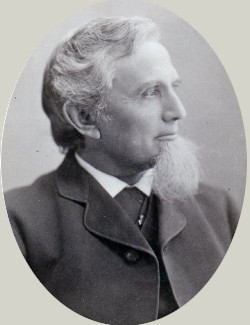Sep 1, 2020

William S. Tilden was one of Medfield’s two most important and prolific historians.
(The other is, of course, Richard DeSorgher, who grew up here, taught history and social studies here for over thirty years, published four books on Medfield history, and is still Medfield’s official town historian, though he has lived in Mashpee for almost ten years.)
Tilden (1830-1912) was a lifelong resident, music teacher, music director and organist at the Baptist church, and, in 1891, co-founder and first president of the Medfield Historical Society. He researched and wrote the 556-page “History of Medfield 1651-1886,” the society’s bible.
Tilden was a first-hand witness to many goings on in Medfield in the 19th century, and he wrote many short pieces as well as his magnum opus. Fortunately, Tilden had very neat and legible handwriting, and many of these pieces have been collected and transcribed and are in a loose-leaf binder at the society. It gives an often light-hearted picture of characters and events of the 19th century of our little farming village, in which the population grew from 745 in 1800…to 966 in 1850…to 1583 in 1900, not counting the 1,343 at the state hospital.
Here’s a sample, written about 1880.
____
Wm. S. Tilden
Until recent years it was the custom at Town meeting to appropriate a certain sum for the repairs of the highways, and each man’s proportion of this was made out separately and called his “highway tax.” The town was divided into five highway districts, called the East, West, Southeast, Southwest, Northeast and Northwest. A “highway surveyor” was chosen in town meeting for each of these districts, and a list of the tax payers with the amount of their taxes was committed to the several surveyors. A few persons paid this tax in money; but the farmers generally came on with their teams and help, and worked it out under direction of the surveyor. Men were allowed ten cents an hour, a yoke of oxen the same, and boys of fourteen or sixteen, half that sum.
It was the business of the surveyor to decide where the work was needed, notify the taxpayers when to appear for work, (usually in the month of June), keep account of their time, and oversee the labor. Our boyish recollections of “working on the road” are in the Southwest district.
Most of the men did a fair amount of work and earned their ten cents an hour. Occasionally, an old man that had been on every year since he was a boy, and could not well be rejected, although past his usefulness, spent the time in telling stories, and leaning over the shovel. Such were generally given some light work to do, such as leveling the surface, etc. We well remember poor old Uncle Tim Hamant, hobbling on with his lame leg, doling that kind of work. We boys, seeing the whole neighborhood turning to in this manner, absorbed the enthusiasm of the occasion, and worked with much more zeal than wisdom; throwing the material into exactly the wrong place, and scattering gravel into the necks of the men while shoveling in the pit.
A favorite method of repairing roads in those days, was to plough up the sides and the gutters, and, with shovels, throw the loam and sandy gravel into the middle of the road. The first thing was to go after Clark Smith’s great plow, a monstrous old-fashioned instrument, made of wood and shod with iron, which had come down from former generations, – the times when the hardy pioneers were breaking up new land. As it seems to us now, it must have been eight or ten feet long. Four or five yoke of oxen were hitched on, some self-confident person assumed to hold the handles, while the spry young men rode the beam to keep it to the ground. With a great deal of shouting and liberal use of whiplash, the oxen strained forward, the plough meanwhile digging its unsteady way through the hard soil, and among the stones. Occasionally considerable headway would be attained; and then a boulder would suddenly arrest progress, giving the man at the handles a tremendous lurch, and throwing the youngsters on the beam to right and left. Great applause greeted this performance, and the participants gathered themselves together for a repetition of it, amid the laughter of the “men and boys.”
But the interest of the day culminated for us when we came upon a rock that must be blasted out. Somebody went after blasting tools, paper for the fuse, tow for the train (there was no safety fuse then), and the big powder-horn. A hole of sufficient depth was drilled; old Lem Thompson was set to load it, tamping it with pounded brick around the paper fuse with a tapering steel rod inside which was afterward withdrawn and the orifice filled with powder. Then the tow was strung out a foot or two from it, and sparsely sprinkled with powder.
Now the supreme moment arrived: everybody was warned to get out of the way, and one of the young men stole up and touched it off, and ram like a sprinter for some safe place. Then the explosion came; and the whole crowd rushed up to see what execution had been done. We boys always hoped it might not be too great, so that another blast would be required.
Thus were the roads repaired in earlier days; they were improved and made passable at comparatively small outlay of money. But better methods of working have succeeded, and the highways are comparably better cared for at present, and much pleasanter to travel.